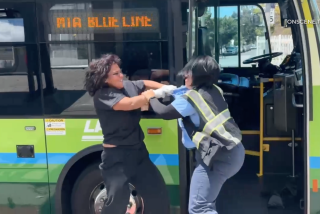Belts for OCTA Bus Passengers? : Transportation: A recent crash has renewed the debate. Proponents say the devices would promote safety, but experts disagree.
- Share via
SANTA ANA — When 12 Orange County bus passengers were injured in a crash earlier this month, bus riders, consumer groups and officials asked: Why were there no seat belts?
Transportation officials immediately explained that state and federal rules only require a seat belt for the driver.
But the Jan. 14 crash, in which an Orange County Transportation Authority bus hit an illegally parked big-rig truck in downtown Los Angeles, has renewed the debate over whether, government regulations aside, OCTA should install seat belts for passengers.
In response to the accident, Sarah Catz, an alternate on the OCTA board, last week asked the staff to look into the possibility of equipping all 507 of the agency’s large buses with safety restraints. She credited a seat belt for saving her life several years ago when her car hit a big-rig truck in Indiana.
The staff’s response, expected this week, will be a recommendation against seat belts, OCTA officials said.
The recommendation will be based on two decades of studies by researchers that contend that large public transit buses are among the safest modes of travel and that passengers on them are actually less likely to be injured if they are not wearing seat belts.
“You’re safer in a big transit bus than anything else on the road,” said Dr. Phyllis Agran, a UC Irvine pediatrician whose research led to the current federal law mandating safety restraints in privately owned vehicles for children weighing less than 40 pounds.
OCTA operations manager John Catoe agreed with Agran’s assessment, saying there is no evidence that any of the injuries that occurred in the Los Angeles crash could have been prevented by the use of seat belts.
The bus driver, Angelo Manuel Ordonez, 26, was cited once last year for driving without a seat belt. Under California law, drivers of transit buses must wear safety restraints to protect their ability to control their vehicles during a crash. Passengers are exempt, based on testimony by safety experts and the cost of installing restraints in buses.
A spokesman for Gillig Corp., which manufactures about 500 buses a year for OCTA and transit agencies throughout North America, said it would cost about $200 per seat belt, or more than $5 million, to equip OCTA’s 507 large buses.
But, OCTA’s Catoe said, “cost has nothing to do with this. It’s simply that, according to one study prepared for the California Highway Patrol, for example, you’re 30 times less likely to be injured without the belt than a passenger in an automobile with the seat belt on.”
Several research projects undertaken by UCLA and other academic institutions for either state or federal regulators have reached similar conclusions.
Separate studies in the United States and Canada, for example, showed that safety belts hinder passengers’ tendency to flip up and over the seats in front of them during a crash. When belts are worn, studies show, a passenger’s head or chest strikes the seat in front.
Further, the most likely source of injury, according to safety experts, is from flying glass.
Research has also found that:
* It’s “impractical” to have seated passengers wear seat belts for even short distances while dozens of “unbelted” people are left standing in the aisle. A seated passenger would have to unbuckle and then navigate the gantlet of unbelted “standees” in order to get to an exit.
* The frequent vandalism to buses would tend to make seat belts inoperable.
* Passengers with arms full of packages won’t use seat belts.
Even consumer advocate Ralph Nader’s Center for Auto Safety in Washington has backed off efforts to have seat belts required on buses.
Said Clarence Ditlow, the center’s executive director: “Around 1973 we tried to get regulatory agencies interested in this, but we didn’t get anywhere. We still feel they’re a good idea, but it has become a low priority--there just aren’t a lot of fatalities involving large buses.”
Three people died in transit bus crashes in 1991 nationwide, the last year for which data is available. The largest number of deaths in any 12-month period since 1980 has been six, according to the National Highway Traffic Safety Administration.
And so far, federal officials said, no transit authority in the United States has installed seat belts on large buses. States are moving toward requiring seat belts on school buses, which have experienced more fatalities, but so far none requires the devices except in vans.
None of this has stopped some personal-injury lawyers from filing lawsuits against transit agencies and bus manufacturers citing the lack of safety restraints. So far, however, none has been successful, transit industry and federal safety officials said.
In a recent claim against OCTA, for example, a lawyer abandoned the issue, conceding that he would have been breaking new ground.
U.S. Bus Deaths Since reaching a five-year high in 1988, bus-accident fatalities have dropped sharply. Nearly all of the decline can be attributed to fewer deaths from school bus accidents. 1987: 51 1988: 54 1989: 50 1990: 32 1991: 31
Type of Bus 1987 1988 1989 1990 1991 Transit 3 2 1 3 3 Cross-country, 19 8 3 2 6 inter-city School 14 38 33 13 10 Other 15 6 13 14 12
Source: National Highway Traffic Safety Administration
More to Read
Sign up for Essential California
The most important California stories and recommendations in your inbox every morning.
You may occasionally receive promotional content from the Los Angeles Times.













